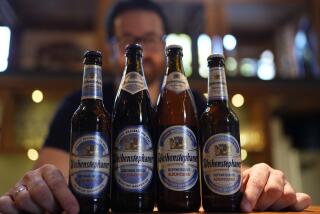Halls of fame
- Share via
MUNICH, GERMANY — The last thing I expected as I slid my fingers through the handle of my first tankard of beer in Munich was 10,000 voices erupting in a ragged rendition of . . . “Hang On Sloopy.” There was no mistaking it, even when sung with a German accent.
I was in a cavernous beer tent at Oktoberfest, Munich’s salute to its favorite liquid, and like everyone around me, I was determined to squeeze the last drop of fun from the world’s biggest kegfest.
But “Hang On Sloopy”? Why not “Danke Schoen”? Why not “Beer Barrel Polka”?
That wasn’t the half of it, though. They followed “Sloopy” with “New York, New York” and then did a foot-stomping, hand-clapping rendition of “We Will Rock You.” With each English-language pop song, I felt more at home. Of course, drinking all that beer didn’t hurt.
I had come here to raise a toast to Germany’s beer halls, national treasures that don’t get nearly the publicity (maybe “buzz” is the more appropriate word) they deserve. Scenic wonders are crammed into every corner of Western Europe’s most populous nation: snowcapped Bavarian Alps, wind-swept North Sea islands, lush Black Forest and castle-dotted Rhine. But if you haven’t explored the country’s cavernous beer halls, you haven’t lived.
My mission was clear: Chart a trail that others could follow; develop a beer hall crawl through the heart of Germany.
Like most travelers, I had limited time and funds -- only a week to see and savor the nation’s finest; far too little time to devote to a country that considers beer and bread the world’s oldest sources of nourishment. So I knocked on the door of the German tourist board: Could it help me identify the best of the best? With its help and input from Deutschland distillers, I made a list of cities with great beer traditions: Cologne, Munich, Bamberg and Bremen. (If your favorite didn’t make the cut, there’s always next time.)
Off to Cologne
Germany is awash in beer. As tourist posters phrase it: “Want a beer? We can give you 5,000.” The country has 1,300 breweries. Exports account for some of the 2.5 billion gallons produced annually, but Germans drink their fair share -- an average of 37 gallons per person. In some areas, that number doubles. “People call us the town of the pregnant men because there are so many big bellies,” said a guide in Bamberg, where the average is 76 gallons per person.
As luck would have it, I arrived in Germany during Oktoberfest, the biggest and boldest of Germany’s many beer festivals. Don’t let the name Oktoberfest fool you: It actually begins in mid-September and ends early in October; this year it’s Sept. 19 to Oct. 4.
Munich wasn’t my first stop on this beer hall crawl. I flew from L.A. to Frankfurt, where I met a friend, Jorden Nye. We hopped a train and buzzed one hour northwest to the ancient Roman city of Cologne, one of Germany’s oldest towns.
Cologne (Koln, in German) has recently become a cosmopolitan superstar known for its art, culture and excellent museums.
We had time for only a quick stroll, but impressive sights flashed by: Cologne Cathedral, one of the most famous Gothic structures in Germany; a bevy of Romanesque churches; colorful houses on Fischmarkt; intriguing clusters of museums and art galleries. Unfortunately, other culture had to take a back seat on this trip; Jorden and I were overdue at the local pubs, where we planned to toast our trip with Kolsch, Cologne’s best-known brew.
We began at Malzmuhle (6 Heumarkt), where waiters in long aprons dashed back and forth serving Kolsch to patrons at sturdy wooden tables. As soon as one glass emptied, a full one took its place. The light-yellow Kolsch is brewed with lots of hops and served at room temperature in Stangen, straight, narrow glasses that hold only about 6 ounces of beer. Along with the brew, patrons consumed plates of hearty German foods, such as boiled pork with sauerkraut and mashed potatoes, and Heaven-and-Earth, which is fried blood pudding with mashed potatoes and apples. The dishes cost about $10 each.
Kolsch has little carbonic acid and just 5% alcoholic content. “You can drink it like water, but it does the trick,” said Andre Fischer, a sixth-generation Cologner who raised a few glasses with us. The beer was fruity and refreshing, qualities that make it beloved by millions and disliked by just as many.
I liked the light taste and wanted to try more varieties of it, so we moved on, visiting a couple of brew pubs in the city’s Old Town and then finishing our evening near the cathedral at Fruh (12 Am Hof), Cologne’s most famous brew pub. The brewery, more than 100 years old, draws locals and tourists alike. The beer is light and easy to drink, and this time we toasted Kolsch and Fruh.
The next morning I told myself I didn’t have a headache as we walked to the train station, pulling our bags behind us, then dozed off quickly as the fast, quietly efficient TGV train barreled 4 1/2 hours southeast to Munich, Bavaria’s capital.
As we drew closer, the car became noisier. Teenage drinkers (16-year-olds can legally drink in Germany) were guzzling beer and raising a ruckus. I wondered aloud whether I’d hate the rowdiness of Oktoberfest. The woman seated next to me surprised me by answering. Edith Fuess, a doctor in Ludwigshafen, Germany, said I’d probably like the friendliness of the event despite the uproar.
“The German people are not so friendly at first,” she said. “But with one beer, they are very friendly.”
Bustling Munich
When Jorden and I emerged from the train, we found a city bursting at the seams; we’d been lucky to find accommodations. Munich, one of Germany’s largest cities, also is one of its major tourist attractions, full of imposing buildings and interesting shops and museums, so we meandered through the city center.
But we managed to home in on our subject. We dropped in for some information at the Bier und Oktoberfestmuseum, which traces 5,000 years of beer history and also has tasting samples (2 Sterneckerstrasse, www.bier-und-oktober festmuseum.de).
Among the things we learned: German beer is still brewed as the law has stipulated since 1516 -- from malt, water, hops, yeast and nothing else.
“Its purity is the reason why it’s such an outstanding product,” said Lukas Bulka, the museum director. “No preservatives, no artificial color or flavors.”
The next stop I’d planned was Hofbrauhaus (9 Platzl), Munich’s world-famous beer hall, but like the city, the brewery was overflowing. Jorden took a pass, but I squeezed in. Hofbrauhaus, established as a court brewery in the 16th century, holds about 2,300 revelers inside and seats more in its beer garden. Tourists drink, listen to oompah bands and watch leg-slapping Bavarian dances. That day, the din of the crowd was nearly deafening, and I finally gave up when I couldn’t order a beer.
I hoped we’d do better at Oktoberfest. Free tickets are available for the festival in advance ( www.oktoberfest.de/en/ navitem/Tents/), but getting them can be complicated. We had decided to take our chances and wait in line to get in, a bad idea on weekends or evenings, when lines are long. But we arrived on a weekday afternoon and in less than an hour, we were seated in the Schottenhamel tent, one of 14 huge temporary beer halls that house celebrants during the event. Costumed servers appeared as soon as we sat down, and 1-liter glass mugs quickly materialized full of Spatenbrau beer, a special copper-colored Oktoberfest variety that has a fresh taste and a malty flavor.
Many partyers wore traditional Bavarian clothing, with men sporting lederhosen (leather breeches with suspenders) and women clad in dirndl; all were wearing smiles. Before long, we were singing in unison with the people at the tables around us. We swayed in time to the music, mugs in hand and toasts on our lips.
As the hour grew later and later, we tore ourselves away, hating to leave but recognizing that duty called.
Symphony in B
By the next afternoon we were on a train headed north to lovely Bamberg, a UNESCO World Heritage city built on seven hills, much like ancient Rome. The hills provide superb views of a beautifully preserved Old Town crisscrossed by branches of the Regnitz River. Some consider the city’s Domplatz to be one of Europe’s loveliest squares, and many of the city’s buildings, including the Cathedral of St. Peter and St. George, are magnificent.
But Bamberg has other claims to fame. It has the highest concentration of breweries in the world and calls itself the true home of beer, a place that is “a symphony in B -- Baroque, bread, bridges and beer.” Our work was cut out for us.
We made our first stop at Klosterbrau (3 Obere Muhlbrucke), founded in 1533 and the city’s oldest brew pub. I felt as though I were stepping back into history at this atmospheric place, which had a plethora of fine beers on tap.
There were many good brew pubs in this town of 70,000 but one stood out: Schlenkerla, known for its smokebeer, a Bamberg specialty (6 Dominikanerstrasse, www.smokebeer .com). The black, dry beer tastes of smoked ham.
Matthias Trum, whose family has operated the brewery for six generations, put his business into perspective: “We’ve been through the Thirty Years’ War, the Great Depression, two world wars, and the brewery is still here,” he said. “So when people say to me, ‘How do you change things?’ I say, ‘I don’t.’ ”
Last stop: Bremen
Bidding auf Wiedersehen to Bamberg, we boarded a train that took us four hours northwest to Bremen, a maritime city dominated by an interesting Old Town, cathedral and town hall. The special draw for us was Beck’s, Germany’s largest brewery.
The classic German lager, responsible for 30% of all German beer exports, is manufactured along the banks of the Weser River. We toured the plant, where we tasted the original Beck’s (crisp and smooth) and some of the more unusual brews made for the domestic market: beer mixed with lemonade, green tea, Sprite and Fanta Orange.
We learned, among other things, that beer is the oldest beverage produced by man.
“We think it happened something like this,” a guide said. “A woman forgot to take fresh bread back into her house, it rained and fermentation began.”
Yes, an oversimplification. But I’ll drink to her anyway. Just not with a beer mixed with Fanta Orange.
--
--
(BEGIN TEXT OF INFOBOX)
If you go
THE BEST WAY TO GERMANY
From LAX, nonstop service to Munich is offered on Lufthansa, and connecting service (change of planes) is available on United, Air France, Lufthansa, British and KLM. Restricted round-trip fares begin at $535.
TELEPHONES
To call these numbers from the U.S., dial 011 (international dialing code), 49 (Germany’s country code) and the local number.
WHERE TO STAY
Hotel Europa, 6 Untere Konigstrasse, Bamberg 96052; 951-309-3020, www.hotel-europa-bamberg.de. Friendly, recently renovated hotel is a five-minute walk from Old Town. Italian restaurant on premises. Doubles from $199, breakfast included.
Hotel Ueberfluss, 72 Langenstrasse, Bremen 28195; 421-322860, www.hotel-ueberfluss.de. Contemporary riverside hotel with large, comfortable rooms. Doubles from $258, including breakfast.
Frankfurt Marriott Hotel, 2 Hamburger Allee, Frankfurt 60486; 69-7955-2501, www.frankfurt-marriott.com. By the main train station. Spacious rooms, great views. Doubles from $223.
WHERE TO EAT
All of the brew pubs mentioned in this story serve hearty German fare at reasonable prices. Entrees such as pork steak, ribs, braised beef or sausage are often combined with mashed potatoes and apples; the cost is usually less than $20, often around $10.
Augustiner Restaurant, 27 Neuhauserstrasse, Munich 80331, 89-23-183-257, www.augustiner-restaurant.com. This famous restaurant serves Bavarian specialties and the popular Augustiner beer. Noisy, fun. Try the sausage, the restaurant’s specialty. Most entrees less than $15.
Bremer Ratskeller, Am Markt, 28195 Bremen; 421-32-16-76, www.ratskeller-bremen.de. For 600 years, the Ratskeller, under the old town hall, has been the place to dine in Bremen. Atmospheric, cave-like. Entrees about $12 to $32.
TO LEARN MORE
German National Tourist Office, (212) 661-7200, www.germany-tourism.de.
More to Read
Sign up for The Wild
We’ll help you find the best places to hike, bike and run, as well as the perfect silent spots for meditation and yoga.
You may occasionally receive promotional content from the Los Angeles Times.






